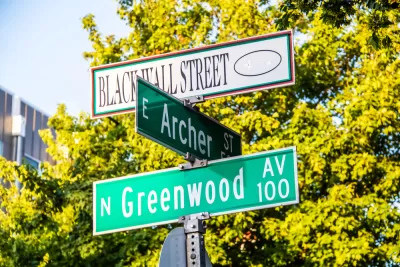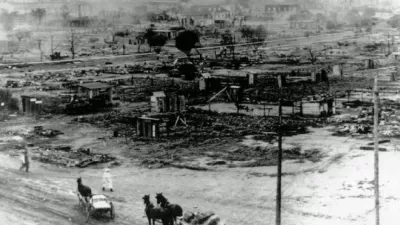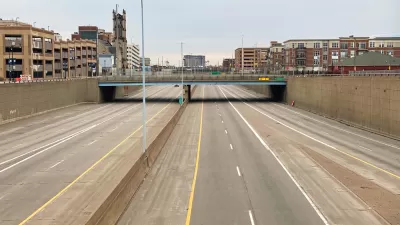After the Tulsa Race Massacre, Greenwood rebuilt strong. Then came "urban renewal."

The Tulsa Daily World’s June 2, 1921 morning edition headline read: “Dead Estimated at 100: City is Quiet. $2000 to Start Fund for Relief. Negros Gladly Accept Guards. 5,000 Negro Refugees Guarded in Camp at County Fairgrounds.”
Fewer than 24 hours after Ku Klux Klan leaders — along with the Tulsa Police Department and the Oklahoma National Guard — carried out the nation’s deadliest and most destructive massacre, Tulsa’s paper of record was already at work crafting a narrative that would shape the way that the city would think about the massacre in Greenwood for the next 100 years.
Thanks to recent scholarship and pop culture depictions of the massacre in Greenwood, more and more Americans are coming to know the story of the Tulsa Race Massacre that destroyed Black Wall Street. But the common narrative — that the massacre destroyed the neighborhood and it never recovered — is incorrect. In fact, Greenwood’s resilient residents rebuilt their community almost immediately after the massacre — in defiance of hastily-enacted racist zoning codes — giving rise to the popular use of the neighborhood’s moniker of Black Wall Street after, not before, the massacre. And while a price cannot be put on the 300 lives lost, the violence that really destroyed Black Wall Street wasn’t physical, but structural.
FULL STORY: Black Wall Street's Second Destruction

Planetizen Federal Action Tracker
A weekly monitor of how Trump’s orders and actions are impacting planners and planning in America.

Maui's Vacation Rental Debate Turns Ugly
Verbal attacks, misinformation campaigns and fistfights plague a high-stakes debate to convert thousands of vacation rentals into long-term housing.

Restaurant Patios Were a Pandemic Win — Why Were They so Hard to Keep?
Social distancing requirements and changes in travel patterns prompted cities to pilot new uses for street and sidewalk space. Then it got complicated.

In California Battle of Housing vs. Environment, Housing Just Won
A new state law significantly limits the power of CEQA, an environmental review law that served as a powerful tool for blocking new development.

Boulder Eliminates Parking Minimums Citywide
Officials estimate the cost of building a single underground parking space at up to $100,000.

Orange County, Florida Adopts Largest US “Sprawl Repair” Code
The ‘Orange Code’ seeks to rectify decades of sprawl-inducing, car-oriented development.
Urban Design for Planners 1: Software Tools
This six-course series explores essential urban design concepts using open source software and equips planners with the tools they need to participate fully in the urban design process.
Planning for Universal Design
Learn the tools for implementing Universal Design in planning regulations.
Heyer Gruel & Associates PA
JM Goldson LLC
Custer County Colorado
City of Camden Redevelopment Agency
City of Astoria
Transportation Research & Education Center (TREC) at Portland State University
Jefferson Parish Government
Camden Redevelopment Agency
City of Claremont





























